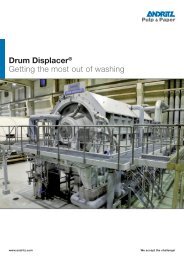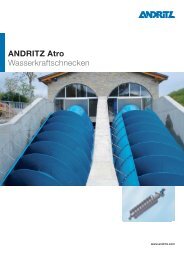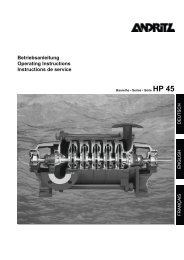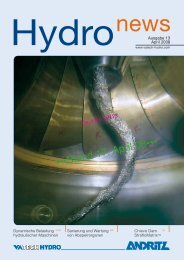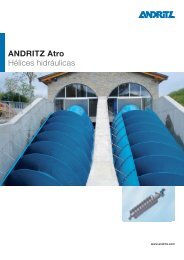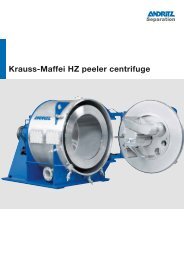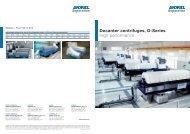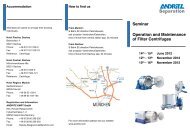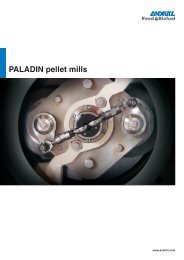Krauss-Maffei SZ pusher centrifuge - Andritz
Krauss-Maffei SZ pusher centrifuge - Andritz
Krauss-Maffei SZ pusher centrifuge - Andritz
You also want an ePaper? Increase the reach of your titles
YUMPU automatically turns print PDFs into web optimized ePapers that Google loves.
6<br />
<strong>Krauss</strong>-<strong>Maffei</strong> <strong>SZ</strong> <strong>pusher</strong> <strong>centrifuge</strong><br />
Operation<br />
Feeding Cake washing Vane-type feed distributor<br />
Function<br />
<strong>Krauss</strong>-<strong>Maffei</strong> <strong>pusher</strong> <strong>centrifuge</strong>s are continuously<br />
operating <strong>centrifuge</strong>s. The product<br />
is fed through a feed pipe (or feed screw in<br />
the case of products which do not flow<br />
freely) into the feed distributor which rotates<br />
with the basket. This accelerates the<br />
slurry and feeds it with uniform distribution<br />
to the feed zone, where the largest portion<br />
of the liquid (approx. 80%) is filtered. In the<br />
feed zone the solids grow to form a stable<br />
filter cake ring. The filter cake is conveyed in<br />
the direction of the solids discharge stroke<br />
by stroke due to the axial relative movement<br />
between <strong>pusher</strong> bottom and screen basket.<br />
During this process an intact filter cake<br />
forms over the entire length of the screen.<br />
As the filter cake progresses from the feed<br />
zone to the solids discharge it can undergo<br />
washing, as required. For this purpose a<br />
wash liquor is applied to the cake surface<br />
and displaces the suspension liquid and impurities.<br />
Multi-stage washing is also possible<br />
with several successive washing zones.<br />
Multi-stage <strong>centrifuge</strong>s with several baskets<br />
loosen the filter cake and reshape it by moving<br />
it from the inner basket to the next larger<br />
basket. As a result of this re-shaping<br />
process, moisture that forms between the<br />
particles is exposed and filtered. The solids<br />
are discharged at the end of the basket after<br />
each <strong>pusher</strong> movement.<br />
Feed conditions<br />
For machine size optimization and maximum<br />
operating reliability it is important to<br />
provide a uniform and concentrated slurry<br />
feed. As upstream equipment such as crystallizers<br />
or reactors frequently do not meet<br />
these requirements satisfactorily, a prethickener<br />
system is usually applied. This<br />
system levels out fluctuations in the feed<br />
conditions and minimizes the hydraulic load<br />
of the <strong>centrifuge</strong>. This can often lead to a<br />
smaller machine size being selected. Stationary<br />
or dynamic equipment have become<br />
established as pre-thickeners, depending<br />
on the type of application. Examples of stationary<br />
equipment are sedimentation tanks<br />
and thickener filters, examples of dynamic<br />
equipment include curved screens, hydrocyclones,<br />
vibration screens, and EC screen<br />
thickeners. In stationary thickeners, a metering<br />
unit is required to control the feed to<br />
the <strong>centrifuge</strong>, and in dynamic thickeners<br />
the feed to the thickener must be monitored.<br />
Feeding<br />
The feed system has the most significant<br />
impact on operation of the <strong>centrifuge</strong>. The<br />
ANDRITZ KMPT patented vane-type feed<br />
distributor has to pre-accelerate the slurry<br />
and distribute it uniformly in the feed zone<br />
in order to achieve uniform cake formation.<br />
Uniform distribution of the slurry is the<br />
basic requirement for trouble-free operation<br />
of the <strong>centrifuge</strong>.




